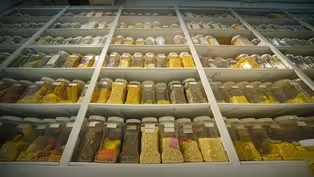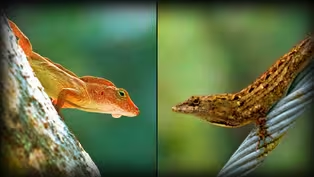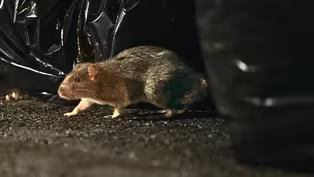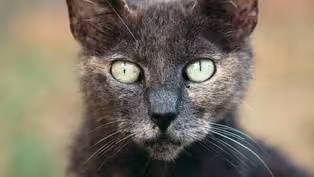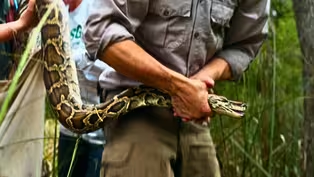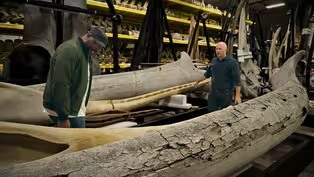
How This Frog Changed Science
Special | 8m 59sVideo has Closed Captions
What happens when frogs become indispensable?
Meet Xenopus, the African Clawed Frog: a strange creature that has opened a window into understanding ourselves in unexpected ways. Join Shane in this episode of Human Footprint as he talks to scientists Jim Hanken, Kelsey Tyssowski, and Marko Horb to find out how one frog become one of the world's most versatile laboratory animals.
Problems playing video? | Closed Captioning Feedback
Problems playing video? | Closed Captioning Feedback

How This Frog Changed Science
Special | 8m 59sVideo has Closed Captions
Meet Xenopus, the African Clawed Frog: a strange creature that has opened a window into understanding ourselves in unexpected ways. Join Shane in this episode of Human Footprint as he talks to scientists Jim Hanken, Kelsey Tyssowski, and Marko Horb to find out how one frog become one of the world's most versatile laboratory animals.
Problems playing video? | Closed Captioning Feedback
How to Watch Human Footprint
Human Footprint is available to stream on pbs.org and the free PBS App, available on iPhone, Apple TV, Android TV, Android smartphones, Amazon Fire TV, Amazon Fire Tablet, Roku, Samsung Smart TV, and Vizio.
Buy Now

Surprising Moments from Human Footprint
Do you think you know what it means to be human? In Human Footprint, Biologist Shane Campbell-Staton asks us all to think again. As he discovers, the story of our impact on the world around us is more complicated — and much more surprising — than you might realize.Providing Support for PBS.org
Learn Moreabout PBS online sponsorshipMore from This Collection
Video has Closed Captions
Watch the rise of a productive crop that has managed to replace itself, but at what cost? (11m 24s)
The Watery Price Of Golf Courses & Lawns
Video has Closed Captions
The cultural and resource costs for manicured lawns and golf courses are quite shocking. (11m 29s)
How Dogs Are Shaping The Future Of Medicine
Video has Closed Captions
Observe the rich diversity of dog breeds, shaped by genes and human intervention. (12m 43s)
We Brought This Fish To America. Now We Can't Get Rid Of It
Video has Closed Captions
Expose Asian carp for disrupting native fish species and shrinking their populations. (10m 39s)
Why Are These Urban Lizards Evolving in Overdrive?
Video has Closed Captions
Examine city-dwelling anoles with remarkable evolutionary changes. (10m 33s)
How An Ancient Ocean Shaped Us History
Video has Closed Captions
Learn how millions of years of deposits shaped the events of Black American history. (16m 54s)
Video has Closed Captions
When it comes to NYC, the rat is the undisputed king! (13m 26s)
Your Cat’s Secret Life (as a Deadly Predator)
Video has Closed Captions
Cats have been winning the hearts of humans for years....but can devastate ecosystems. (10m 40s)
Singapore: Designing a Megacity in Harmony with Nature
Video has Closed Captions
Green spaces aren't just an afterthought here - they're mandatory! (13m 24s)
How Giant Pythons Became Florida’s Biggest Invasive Species
Video has Closed Captions
Ever heard of the phrase "when pet pythons outgrow their owners"? (13m 24s)
Sled Dogs: The Most Extreme Distance Athletes on Earth
Video has Closed Captions
In the Arctic, it's not just about muscle power, but brainpower too. (15m 17s)
Secrets of the World’s Only Whale Warehouse
Video has Closed Captions
Uncover the history of whaling and its impact on our oceans. (9m 58s)
Providing Support for PBS.org
Learn Moreabout PBS online sponsorshipIn the early 1930s, biologists working in southern Africa realized that you could use female Xenopus as an assay for human pregnancy.
Hold up.
A frog that’s a pregnancy test!?
Xenopus, also known as the African Clawed Frog, was minding its own business in South African ponds for millions of years.
But then, something changed.
In the mid-20th century, scientists found a surprising use for these frogs.
And before we knew it, Xenopus labs were popping up everywhere.
The reason: pregnancy tests!
But how can a frog tell you if you’re pregnant?
And why are these frogs so important to science today?
I’m Shane Campbell-Staton, and this is Human Footprint.
Xenopus means strange foot.
Jim Hanken is the Curator of Herpetology at the Harvard Museum of Comparative Zoology.
He was one of my mentors in grad school, and amphibians are his thing.
Three of the hind toes have a black keratinized claw.
I'm assuming that's where “African clawed frog” comes from.
African clawed frog.
You got it.
In grad school, we talked about Xenopus like THE model system.
Model systems are the species we study because there’s something about their biology that gives us deeper insight into how life works.
Model systems are literally the “lab rats” of the scientific world.
It always struck me as the weirdest choice.
Yeah, it’s a historical accident.
In Ancient Egypt people were peeing on wheat, barley and other kinds of grain.
If it sprouts, she's pregnant.
If it doesn’t sprout, she’s not pregnant.
It was actually found to be accurate 75 to 80% of the time.
So this is a pregnancy test that worked, developed 3000 years ago, or more.
Kelsey Tyssowski is a biologist at Harvard who’s written about the history of pregnancy tests.
So it was called the Hogben test, after Lancelot Hogben, who... Lancelot Hogben.
Yes.
Got to be British, if you're named Lancelot.
Now everyone’s got their thing, and apparently Hogben’s thing was injecting animals with urine.
What he discovered is that if you inject a pregnant woman’s urine into a female Xenopus, the frog will ovulate and lay eggs.
What is it exactly, in the urine – There's a hormone in the urine of pregnant women called human chorionic gonadotropin, hCG, and it goes up really really high.
Kelsey explained that when an embryo first implants in a woman’s uterus, her hCG levels spike.
And that hormone turns out to be very similar to another hormone called luteinizing hormone, which causes ovulation.
Okay.
hCG in human urine can cause other mammals to ovulate too…and in the early 20th century, doctors could actually order a mouse or rabbit-based pregnancy test.
They inject into animals.
The problem was, they had to kill and dissect the animal to find out the result.
So the Hogben Test was a revolution.
Demand exploded as Xenopus became the go-to pregnancy test around the globe.
The fact that Xenopus were really useful for pregnancy testing, inspired people to figure out, "How do we keep a lot of Xenopus like living in a lab space?"
Xenopus labs started popping up everywhere And scientists began to realize that they could use these frogs and their eggs to answer all kinds of questions.
Are you pregnant?
Researchers eventually came up with easier ways to measure hCG in urine – no frogs required.
But by then, Xenopus was firmly established as a model system in biology.
They were first used for embryological research after scientists discovered they could breed the frogs in aquariums, Providing a steady supply of robust eggs that didn’t need to be collected in the wild.
More recently, researchers have been studying this frog's ability to regenerate its brain and spinal cord during larval stages.
With these benefits to the scientific community, it was clear these frogs weren’t going anywhere.
How many frogs do you think you have here?
We have over ten thousand frogs.
The epicenter of modern Xenopus research is tucked away in a basement in a quiet town on the coast of Massachusetts: The National Xenopus Resource.
We focus on transgenic, inbred and mutant frogs.
Marko Horb is the director here.
And despite all this talk about mutants…he’s more of a Willy Wonka than a Dr. Moreau.
Somebody wants a mutant, they tell me what gene, I have technicians that work on that, they’ll make the mutant, it's like a shop.
You want something, you order it from me We make it.
And we give it to you.
Different research questions require frogs that carry different combinations of genes.
When a scientist needs a particular collection of genes that hasn’t been assembled before, Marko’s the dude that’ll put it together for them.
And yeah, THIS is actually what he likes to do in his spare time.
What are Xenopus being used for?
Developmental biology…how organs develop and how different cells are formed.
People use the eggs and the oocytes from the frog… Marko’s talking about research that’s already led to new discoveries, technologies, medicines… And will undoubtedly lead to many more.
But in our quest for one kind of knowledge, I can’t help but wonder if we’re leaving another behind.
In the early 1990s, frogs around the world started…disappearing.
In just a few decades, dozens of wild species had been reduced to memories And a few pickled specimens in museums.
We got Rheobatrachus That's Atelopus…This is a poison frog.
[More frog species] Everything that we're looking at here has gone extinct.
All of these are believed to be extinct.
The killer is a fungus called chytrid.
These are fungi that proliferate in the skin of amphibians.
The frog stresses out physiologically and dies.
Biologists literally walking along a mountain stream would see large numbers of dead or dying frogs on the rocks next to the stream, or floating in the water.
It was just unheard of.
Chytrid has probably existed and infected certain amphibians for thousands of years.
What’s new is the massive global trade in amphibians for pets, food, and yeah…science.
Chytrid has spread all over the world exposing frogs and salamanders to a disease many of them have never faced before.
It’s the largest pandemic the world has ever seen.
And in just a few decades, it’s driven dozens of amphibian species to extinction.
And yet, this thing is doing perfectly fine, more than fine.
Some species can resist it very readily, other species cannot.
Xenopus tolerates chytrid infection.
It's a tough frog.
We don't know for sure what role Xenopus are playing in the chytrid pandemic But they certainly aren’t helping.
They can carry chytrid without getting sick.
And thanks to us, they’re world travelers.
Escaped and released frogs have made Xenopus an invasive species on four continents.
Research on these frogs has improved our lives, but as we transformed one frog species into a global phenomenon, we left others on the brink of collapse.
You've dedicated your entire life to understanding these branches of the tree of life.
Do you still remain hopeful about their future?
We know there's tremendous uninventoried, biological diversity out there, unnamed species, undiscovered species, and it's a race against time right now to find them.
So maybe it sounds silly or it's very unsatisfactory, but I find it's a bit of a consolation to get out there and try to while they're still there, try to find them.
And in so doing reveal the further wonders of our planet.
Let's do what we can to save as much as we can.
Agreed.
If you want more Human Footprint, you can tune in to the full length series on the PBS App or on your local PBS station.

- Science and Nature

Explore scientific discoveries on television's most acclaimed science documentary series.

- Science and Nature

Capturing the splendor of the natural world, from the African plains to the Antarctic ice.












Support for PBS provided by:
